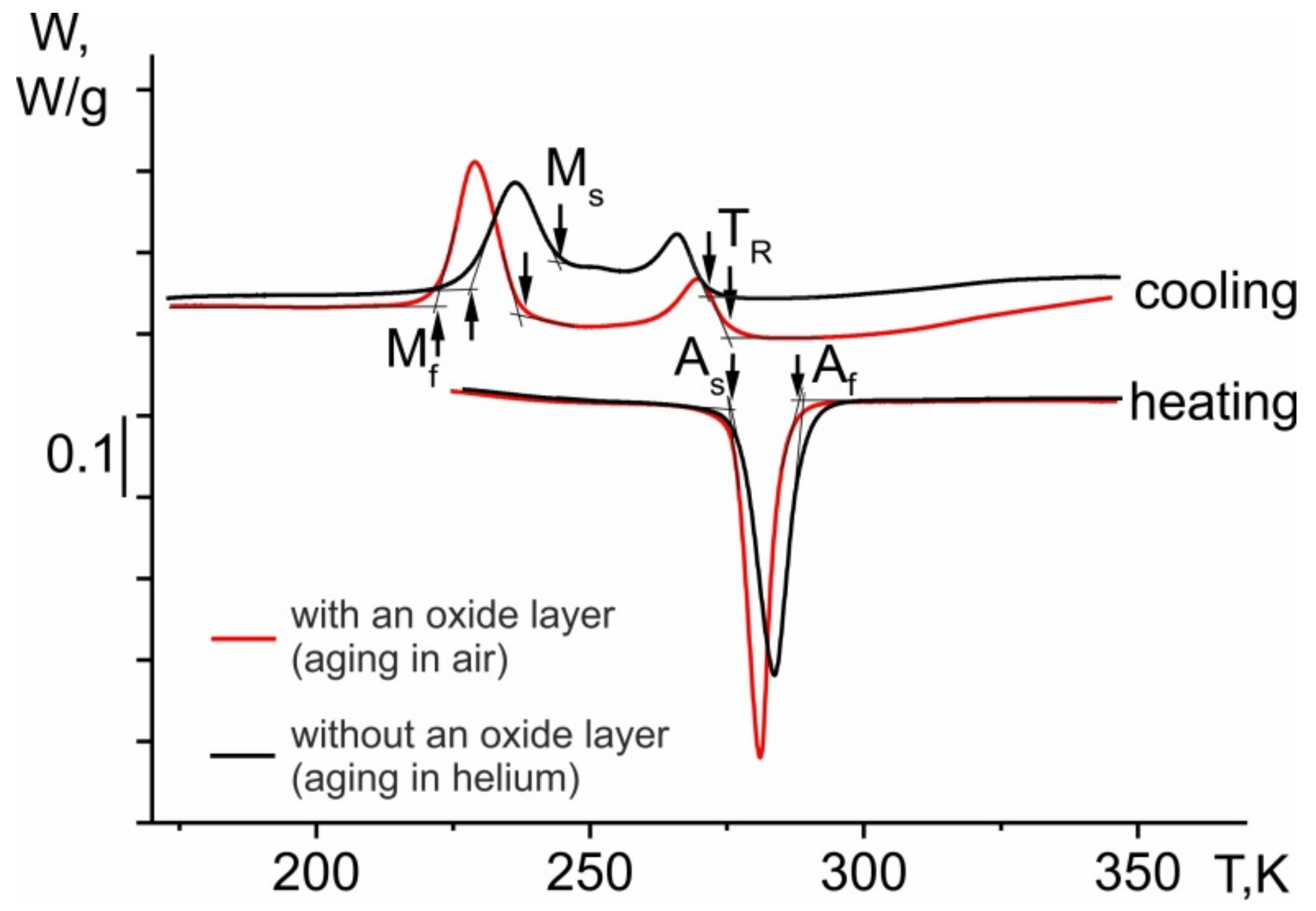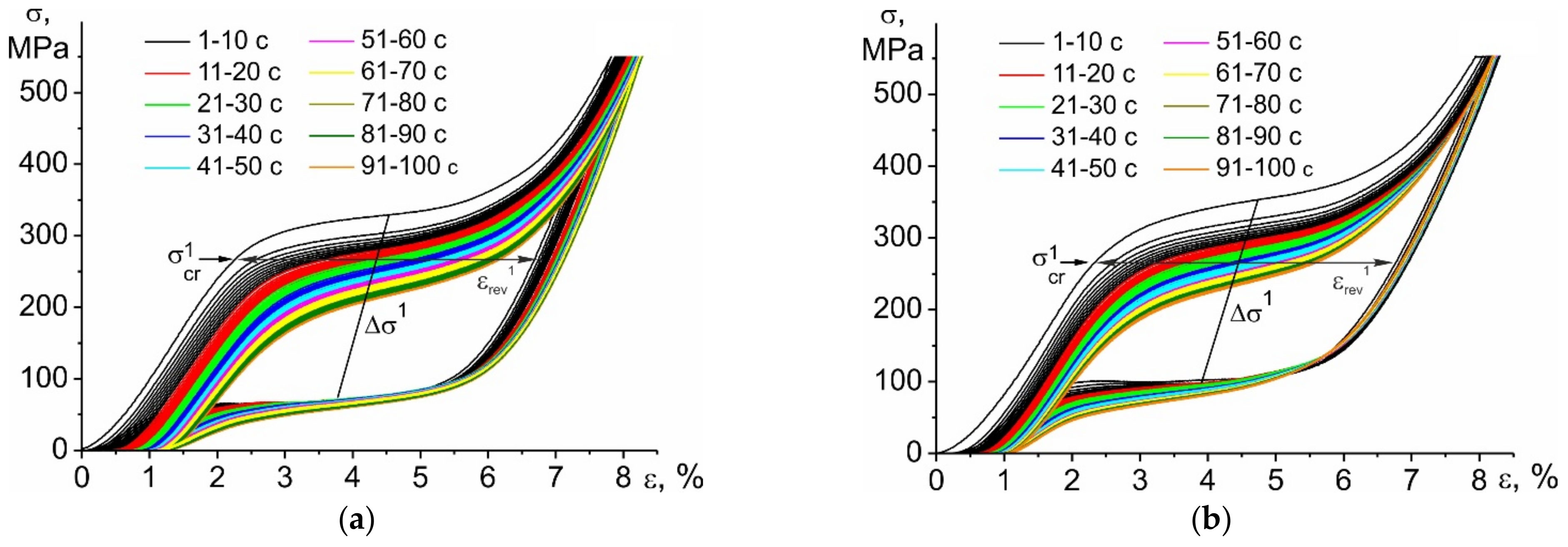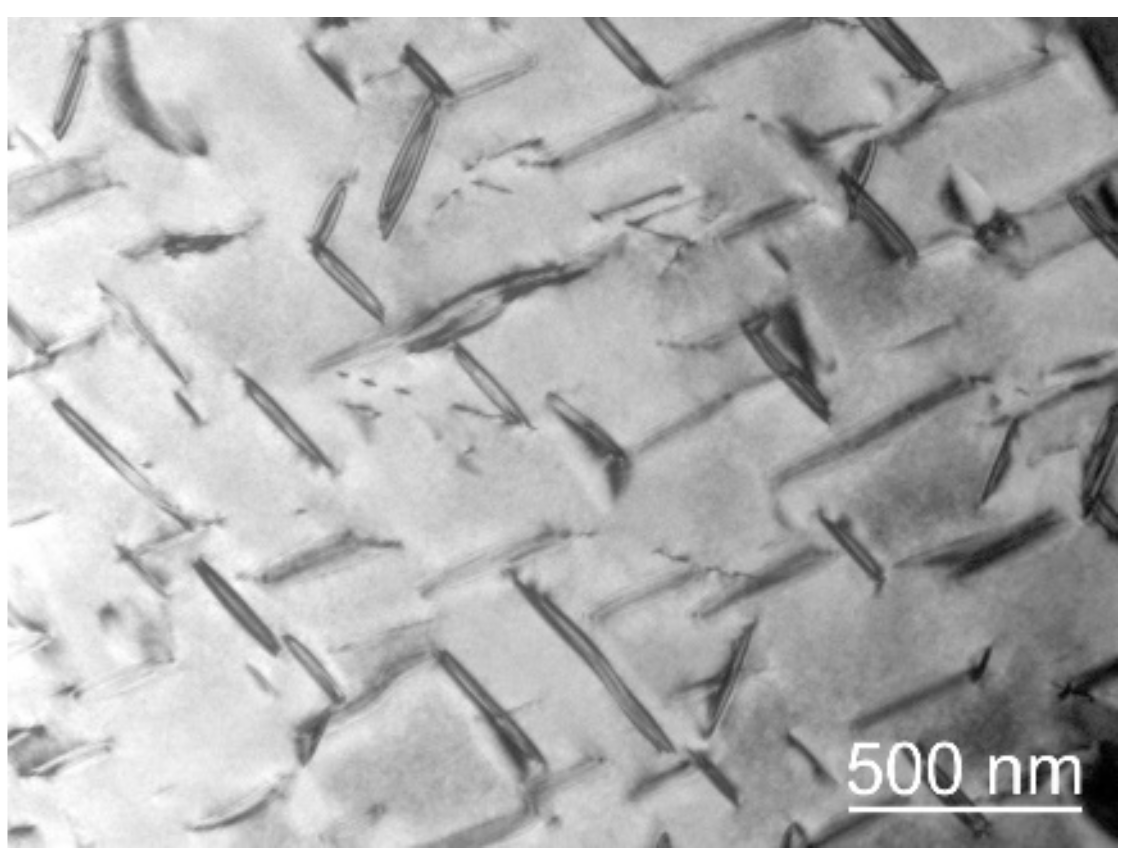The Cyclic Stability of Superelasticity in Aged Ti49.3Ni50.7 Single Crystals with Oxide Surface
Abstract
:1. Introduction
2. Materials and Methods
3. Results
4. Discussion
5. Conclusions
Author Contributions
Funding
Data Availability Statement
Acknowledgments
Conflicts of Interest
References
- Jani, J.M.; Leary, M.; Subic, A.; Gibson, M.A. A review of shape memory alloy research, applications and opportunities. Mater. Des. 2014, 56, 1078–1113. [Google Scholar] [CrossRef]
- Shao, M.; Cui, C.; Yang, H. Surface oxidation as the modification technique of NiTi shape memory alloys for medical application: A technological review. Cailiao Daobao/Mater. Rev. 2018, 32, 1181–1186. [Google Scholar] [CrossRef]
- Nematzadeh, F. A computational study on the effect of bending number on superelastic behavior of NiTi for medical application. J. Intell. Mater. Syst. Struct. 2020, 31, 2117–2127. [Google Scholar] [CrossRef]
- Timofeeva, E.E.; Panchenko, E.Y.; Zherdeva, M.V.; Eftifeeva, A.S.; Surikov, N.Y.; Tagiltsev, A.I.; Chumlyakov, Y.I. Effect of one family of Ti3Ni4 precipitates on shape memory effect, superelasticity and strength properties of the B2-phase in high-nickel [001]-oriented Ti-51.5 at.%Ni single crystals. Mater. Sci. Eng. A 2022, 832, 142420. [Google Scholar] [CrossRef]
- Gall, K.; Maier, H.J. Cyclic deformation mechanisms in precipitated NiTi shape memory alloys. Acta Mater. 2002, 50, 4643–4657. [Google Scholar] [CrossRef]
- Kaya, I.; Karaca, H.E.; Souri, M.; Chumlyakov, Y.; Kurkcu, H. Effects of orientation on the shape memory behavior of Ni51Ti49 single crystals. Mater. Sci. Eng. A 2017, 686, 73–81. [Google Scholar] [CrossRef]
- Timofeeva, E.E.; Surikov, N.Y.; Tagiltsev, A.I.; Eftifeeva, A.S.; Neyman, A.A.; Panchenko, E.Y.; Chumlyakov, Y.I. The superelasticity and shape memory effect in Ni-rich Ti-51.5at.%Ni single crystals after one-step and two-step ageing. Mater. Sci. Eng. A 2020, 796, 140025. [Google Scholar] [CrossRef]
- Hassel, A.W. Surface treatment of NiTi for medical applications. Minim. Invasive Ther. Allied. Technol. 2004, 13, 240–247. [Google Scholar] [CrossRef]
- Chu, C.L.; Wu, S.K.; Yen, Y.C. Oxidation behavior of equiatomic TiNi alloy in high temperature air environment. Mater. Sci. Eng. A 1996, 216, 193–200. [Google Scholar] [CrossRef]
- Firstov, G.S.; Vitchev, R.G.; Kumar, H.; Blanpain, B.; Humbeeck, J.V. Surface oxidation of NiTi shape memory alloy. Biomaterials 2002, 23, 4863–4871. [Google Scholar] [CrossRef]
- Cissé, O.; Savadogo, O.; Wu, M.; Yahia, L.H. Effect of surface treatment of NiTi alloy on its corrosion behavior in Hanks’ solution. J. Biomed. Mater. Res. 2002, 61, 339–345. [Google Scholar] [CrossRef] [PubMed]
- Shabalovskaya, S.A.; Tian, H.; Anderegg, J.W.; Schryvers, D.U.; Carroll, W.U.; Humbeeck, J.V. The influence of surface oxides on the distribution and release of nickel from Nitinol wires. Biomaterials 2009, 30, 468–477. [Google Scholar] [CrossRef] [PubMed]
- Mahmud, A.; Wu, Z.; Zhang, J.; Liu, Y.; Yang, H. Surface oxidation of NiTi and its effects on thermal and mechanical properties. Intermetallics 2018, 103, 52–62. [Google Scholar] [CrossRef]
- Nam, T.H.; Chung, D.W.; Lee, H.W.; Kim, J.H.; Choi, M.S. Effect of the surface oxide layer on transformation behavior and shape memory characteristics of Ti-Ni and Ti-Ni-Mo alloys. J. Mater. Sci. 2003, 38, 1333–1338. [Google Scholar] [CrossRef]
- Shabalovskay, S.; Anderegg, J.; Humbeeck, J. Van Critical overview of Nitinol surfaces and their modifications for medical applications. Acta Biomater. 2008, 4, 447–467. [Google Scholar] [CrossRef]
- Neelakantan, L.; Swaminathan, S.; Spiegel, M.; Eggeler, G.; Hassel, A.W. Selective surface oxidation and nitridation of NiTi shape memory alloys by reduction annealing. Corros. Sci. 2009, 51, 635–641. [Google Scholar] [CrossRef]
- Ng, C.W.; Mahmud, A.S.; Ahmad, M.N.; Razali, M.F.; Liu, Y. Estimation of titanium oxide layer thickness on thermally oxidized NiTi alloy based on color variations. Mater. Werkst. 2022, 53, 47–55. [Google Scholar] [CrossRef]
- Undisz, A.; Schrempel, F.; Wesch, W.; Rettenmayr, M. Mechanism of oxide layer growth during annealing of NiTi. J. Biomed. Mater. Res. A 2012, 100, 1743–1750. [Google Scholar] [CrossRef]
- Sehitoglu, H.; Karaman, I.; Anderson, R.; Zhang, X.; Gall, K.; Maier, H.J.; Chumlyakov, Y. Compressive response of NiTi single crystals. Acta Mater. 2000, 48, 3311–3326. [Google Scholar] [CrossRef]
- Sehitoglu, H.; Jun, J.; Zhang, X.; Karaman, I.; Chumlyakov, Y.; Maier, H.J.; Gall, K. Shape memory and pseudoelastic behavior of 51.5%Ni–Ti single crystals in solutionized and overaged state. Acta Mater. 2001, 49, 3609–3620. [Google Scholar] [CrossRef]
- Guo, W.; Steinbach, I.; Somsen, C.; Eggeler, G. On the effect of superimposed external stresses on the nucleationand growth of Ni4Ti3 particles: A parametric phase field study. Acta Mater. 2011, 59, 3287–3296. [Google Scholar] [CrossRef]
- Zotov, N.; Pfund, M.; Polatidis, E.; Mark, A.F.; Mittemeijer, E.J. Change of transformation mechanism during pseudoelastic cycling of NiTi shape memory alloys. Mater. Sci. Eng. A 2017, 682, 178–191. [Google Scholar] [CrossRef]
- Xie, X.; Kan, Q.; Kang, G.; Li, J.; Qiu, B.; Yu, C. Observation on the transformation domains of super-elastic NiTi shape memory alloy and their evolutions during cyclic loading. Smart Mater. Struct. 2016, 25, 045003. [Google Scholar] [CrossRef]
- Kan, Q.; Yu, C.; Kang, G.; Li, J.; Yan, W. Experimental observations on rate-dependent cyclic deformation of super-elastic NiTi shape memory alloy. Mech. Mater. 2016, 97, 48–58. [Google Scholar] [CrossRef]
- Otsuka, K.; Ren, X. Physical metallurgy of Ti–Ni-based shape memory alloys. Prog. Mater. Sci. 2005, 50, 511–678. [Google Scholar] [CrossRef]
- Li, J.-F.; Zheng, Z.-Q.; Li, X.-W.; Li, S.-C. Effect of compressive stress aging on transformation strain and microstructure of Ni-rich TiNi alloy. Mater. Sci. Eng. A 2009, 523, 207–213. [Google Scholar] [CrossRef]
- Michutta, J.; Carroll, M.C.; Yawny, A.; Somsen, C.; Neuking, K.; Eggeler, G. Martensitic phase transformation in Ni-rich NiTi single crystals with one family of Ni4Ti3 precipitates. Mater. Sci. Eng. A 2004, 378, 152–156. [Google Scholar] [CrossRef]
- Chen, L.Q.; Li, D.Y. Selective variant growth of coherent Ti11Ni14 precipitate in a TiNi alloy under applied stresses. Acta Mater. 1997, 45, 471–479. [Google Scholar] [CrossRef]
- Gloanec, A.-L.; Cerracchio, P.; Reynier, B.; Van Herpen, A.; Riberty, P. Fatigue crack initiation and propagation of a TiNi shape memory alloy. Scr. Mater. 2010, 62, 786–789. [Google Scholar] [CrossRef] [Green Version]
- Tyca, O.; Hellera, L.; Vronkaa, M.; Šittnera, P. Effect of temperature on fatigue of superelastic NiTi wires. Int. J. Fatigue 2020, 134, 105470. [Google Scholar] [CrossRef]







| Single Crystals | Ms (±2), K | Mf (±2), K | As (±2), K | Af (±2), K | TR (±2), K | ΔT (±2), K |
|---|---|---|---|---|---|---|
| with an oxide layer (aging in air) | 238 | 221 | 276 | 288 | 275 | 50 |
| without an oxide layer (aging in helium) | 244 | 227 | 277 | 289 | 271 | 45 |
Publisher’s Note: MDPI stays neutral with regard to jurisdictional claims in published maps and institutional affiliations. |
© 2022 by the authors. Licensee MDPI, Basel, Switzerland. This article is an open access article distributed under the terms and conditions of the Creative Commons Attribution (CC BY) license (https://creativecommons.org/licenses/by/4.0/).
Share and Cite
Eftifeeva, A.S.; Panchenko, E.Y.; Fatkullin, I.D.; Volochaev, M.N.; Tagiltsev, A.I.; Chumlyakov, Y.I. The Cyclic Stability of Superelasticity in Aged Ti49.3Ni50.7 Single Crystals with Oxide Surface. Metals 2022, 12, 2113. https://doi.org/10.3390/met12122113
Eftifeeva AS, Panchenko EY, Fatkullin ID, Volochaev MN, Tagiltsev AI, Chumlyakov YI. The Cyclic Stability of Superelasticity in Aged Ti49.3Ni50.7 Single Crystals with Oxide Surface. Metals. 2022; 12(12):2113. https://doi.org/10.3390/met12122113
Chicago/Turabian StyleEftifeeva, Anna S., Elena Y. Panchenko, Ilya D. Fatkullin, Mikhail N. Volochaev, Anton I. Tagiltsev, and Yuriy I. Chumlyakov. 2022. "The Cyclic Stability of Superelasticity in Aged Ti49.3Ni50.7 Single Crystals with Oxide Surface" Metals 12, no. 12: 2113. https://doi.org/10.3390/met12122113





